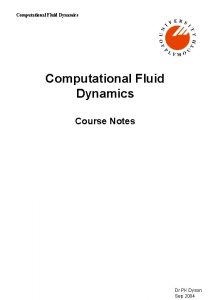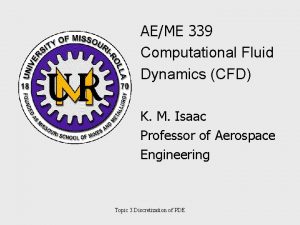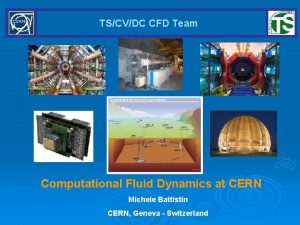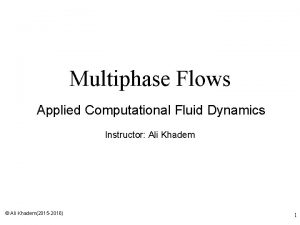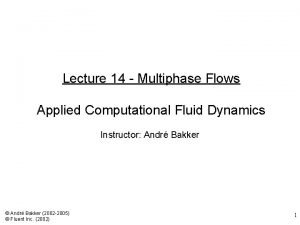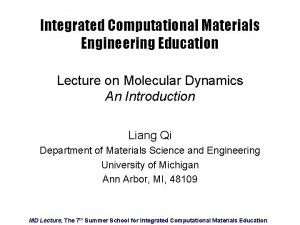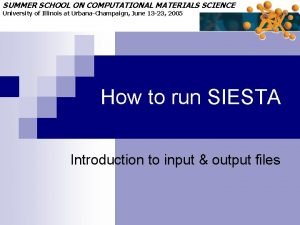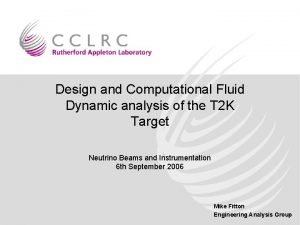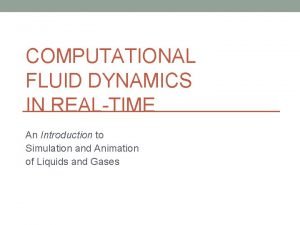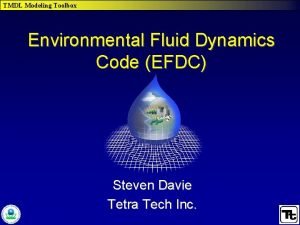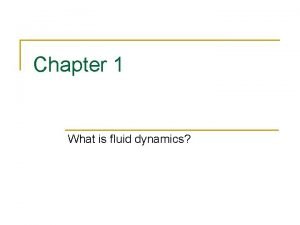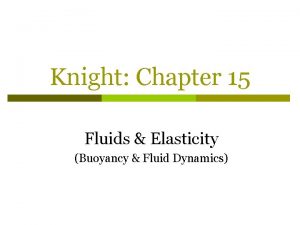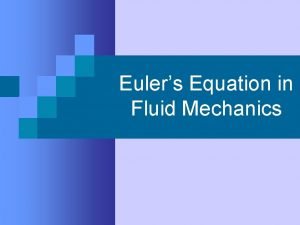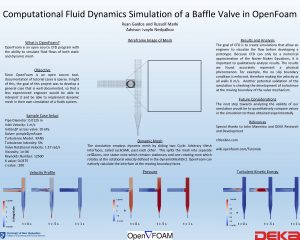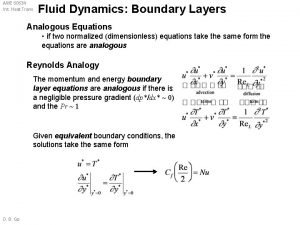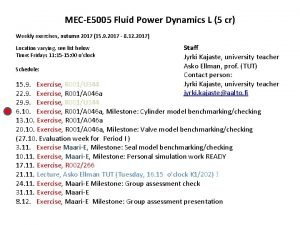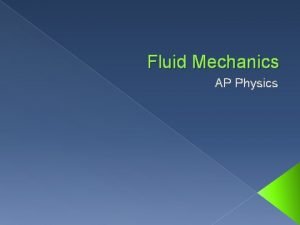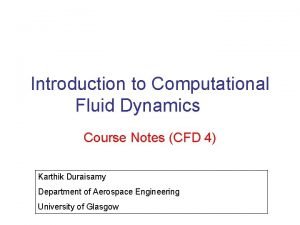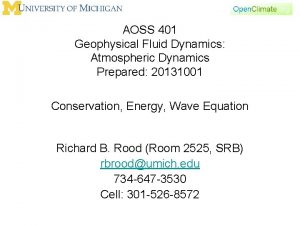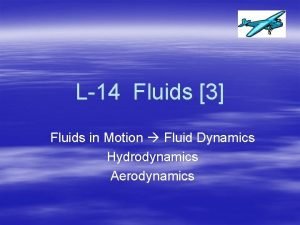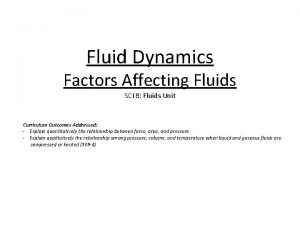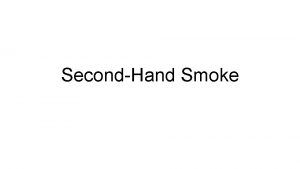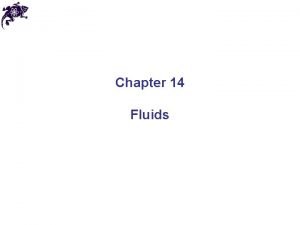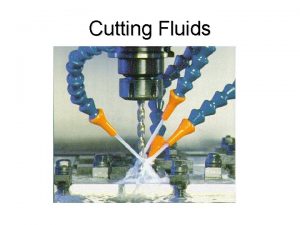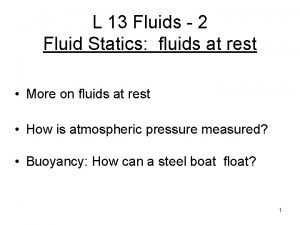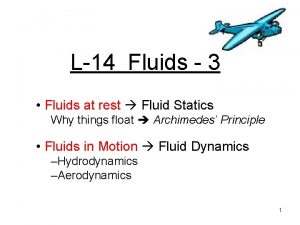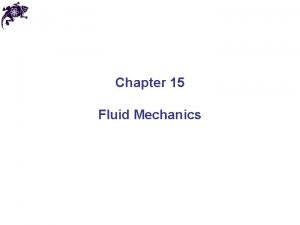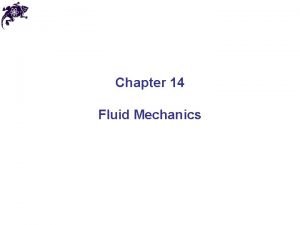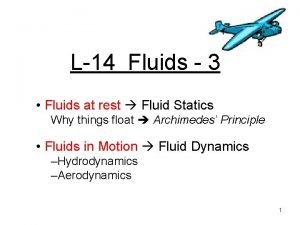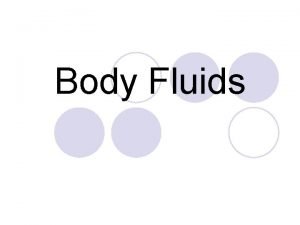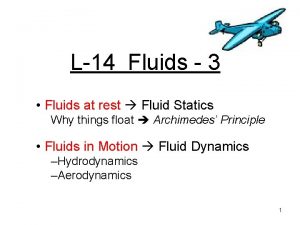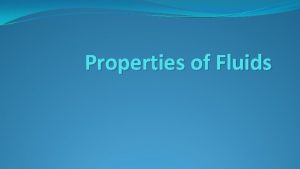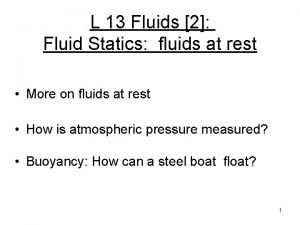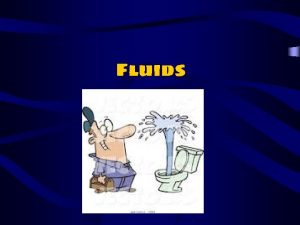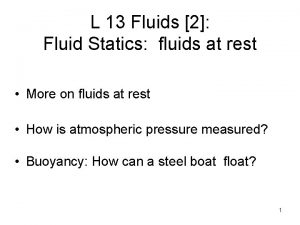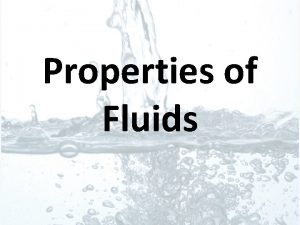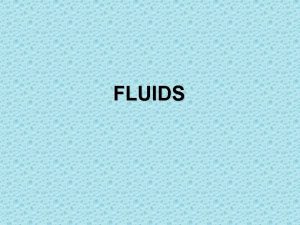Computational Fluid Dynamics Fluids Fluid materials Smoke like



































- Slides: 35

Computational Fluid Dynamics

Fluids �Fluid materials �Smoke like phenomena �Clouds �Dyeing

State of the fluid �Velocity (vector field) x = (x, y) position u = (u, v) velocity T time u(x, t) = (u(x, t), v(x, t)) Cartesian grid

Navier-Stokes equations (1822) �Claude Navier and George Gabriel Stokes Movements of fluids �Basic assumptions Two components of stress in fluids ▪ Diffusion proportional to the gradient of the velocity ▪ Pressure

Navier-Stokes equations (1822) �Can describe several physical phenomena Weather Flows in ducts with non-circular cross-section Flows around the wings of aircrafts Movements of solid bodies through fluid like materials (movements in stars in galaxies) Can be connected to the Maxwell equations (Magnetohydrodynamics)

Navier-Stokes equations (1822) �It is also important from theoretical point of view Existence and smoothness of Navier-Stokes solutions in 3 D One of the seven Millennium Problems by Clay Mathematics Institute ▪ One million dollar for the solution

Navier-Stokes equations (1822) density Viscosity (kinematic) External forces Incompressible, homogeneous fluids

Parts of the equations I. �Advection �Forward movement, transport �Any quantity �Own vector field as well

Parts of the equations II. �Pressure �Force transmission is not instaneous in fluids �Molecule collision creates pressure �It causes acceleration

Parts of the equations III. �Diffusion �Different fluids move differently: there are more dense and more viscous ones �Viscosity: the resistance of the fluid against the flow �This resistance causes velocity diffusion

Parts of the equations IV. �External forces �Can be local or global ones (e. g. gravity)

Operators Operator Gradient Divergence Laplace Definition Finite difference form

Solving the equations �Analytic solution only in special (simple) cases �Numeric method, incremental solution �If we would like to animate the flow the time integration could be useful �The problem is divided into smaller parts (Stam, J. 1999. "Stable Fluids. " In Proceedings of SIGGRAPH 1999)

Helmholtz-Hodge decomposition (Projection step) �(A vector can be written as a weighted sum of basis vectors) �A vector field can be written as a sum of a divergence-free vector field and gradient of a scalar field

Helmholtz-Hodge decomposition (Projection step) W

How to calculate pressure? Poisson equation

What to do in a step of the simulation? Projection External Force Diffusion Advection

Advection �Euler method, forward step �Not stable, hard to implement in Open. CL �A solution is the backward step :

Advection

Diffusion �Explicit solution: �Not stable! Implicit solution: Poisson equation

Projection Poisson equation

Solution of Poisson equations �Iterative solution, starting from an initial state and progressive refinement �Form of the equation: �Where is the Laplace operator �The most simple solution is the Jacobi method

Jacobi method Diffusion Pressure x velocity (u) pressure (p) b velocity (u) divergence of the velocity field -1. 0 0. 25

Boundary conditions �Calculations are performed only in a finite volume, boundary conditions are needed �If the fluid is surrounded with solid walls, the conditions for the velocity and pressure are: Velocity: it is zero at the boundaries (no-slip condition) Pressure: its gradient is zero at the boundaries (Neumann condition)

Extension: vorticity �The simulation and the error of the numeric discretization makes some details of the flow vanish �Trying to get it back:

Implementation �Quantities are stored in 2 D arrays �During the calculations sometime information is needed form the neighborhood, therefore some quantities are double buffered �Arrays are updated by Open. CL kernels �Separate kernels are needed for different steps of the calculation �The display is a simple drawing to the screen �Kernel functions. . .

Advection __kernel void advection(const int grid. Resolution, __global float 2* input. Velocity. Buffer, __global float 2* output. Velocity. Buffer) { int 2 id = (int 2)(get_global_id(0), get_global_id(1)); if(id. x > 0 && id. x < grid. Resolution - 1 && id. y > 0 && id. y < grid. Resolution – 1){ float 2 velocity = input. Velocity. Buffer[id. x + id. y * grid. Resolution]; float 2 p = (float 2)((float)id. x - dt * velocity. x, (float)id. y - dt * velocity. y); output. Velocity. Buffer[id. x + id. y * grid. Resolution] = get. Bil(p, grid. Resolution, input. Velocity. Buffer); } else{ //határfeltételek if(id. x == 0) output. Velocity. Buffer[id. x + id. y * grid. Resolution] = - input. Velocity. Buffer[id. x + 1 + id. y * grid. Resolution]; . . . } }

Divergence __kernel void divergence(const int grid. Resolution, __global float 2* velocity. Buffer, __global float* divergence. Buffer) { int 2 id = (int 2)(get_global_id(0), get_global_id(1)); if(id. x > 0 && id. x < grid. Resolution - 1 && id. y > 0 && id. y < grid. Resolution - 1){ float 2 v. L v. R v. B v. T = = velocity. Buffer[id. x + + + 1 + id. y * (id. y - 1) (id. y + 1) grid. Resolution]; * grid. Resolution]; divergence. Buffer[id. x + id. y * grid. Resolution] = 0. 5 f * ((v. R. x - v. L. x) + (v. T. y - v. B. y)); } else{ divergence. Buffer[id. x + id. y * grid. Resolution] = 0. 0 f; } }

Calculating pressure, Jacobi method __kernelvoid pressure. Jacobi(const int grid. Resolution, __global float* input. Pressure. Buffer, __global float* output. Pressure. Buffer, __global float* divergence. Buffer) { int 2 id = (int 2)(get_global_id(0), get_global_id(1)); if(id. x > 0 && id. x < grid. Resolution - 1 && id. y > 0 && id. y < grid. Resolution - 1){ float float alpha = -1. 0 f; beta = 0. 25 f; v. L = input. Pressure. Buffer[id. x - 1 + id. y * grid. Resolution]; v. R = input. Pressure. Buffer[id. x + 1 + id. y * grid. Resolution]; v. B = input. Pressure. Buffer[id. x + (id. y - 1) * grid. Resolution]; v. T = input. Pressure. Buffer[id. x + (id. y + 1) * grid. Resolution]; divergence = divergence. Buffer[id. x + id. y * grid. Resolution]; output. Pressure. Buffer[id. x + id. y * grid. Resolution] = (v. L + v. R + v. B + v. T + alpha * divergence) * beta; }else{ //határfeltételek if(id. x == 0) output. Pressure. Buffer[id. x + id. y * grid. Resolution] = input. Pressure. Buffer[id. x + 1 + id. y * grid. Resolution]; . . . } }

Projection __kernel void projection(const int grid. Resolution, __global float 2* input. Velocity. Buffer, __global float* pressure. Buffer, __global float 2* output. Velocity. Buffer) { int 2 id = (int 2)(get_global_id(0), get_global_id(1)); if(id. x > 0 && id. x < grid. Resolution - 1 && id. y > 0 && id. y < grid. Resolution - 1){ float p. L = pressure. Buffer[id. x - 1 + id. y * grid. Resolution]; float p. R = pressure. Buffer[id. x + 1 + id. y * grid. Resolution]; float p. B = pressure. Buffer[id. x + (id. y - 1) * grid. Resolution]; float p. T = pressure. Buffer[id. x + (id. y + 1) * grid. Resolution]; float 2 velocity = input. Velocity. Buffer[id. x + id. y * grid. Resolution]; output. Velocity. Buffer[id. x + id. y * grid. Resolution] = velocity – (float 2)(p. R - p. L, p. T - p. B); } else {//határfeltételek if(id. x == 0) output. Velocity. Buffer[id. x + id. y * grid. Resolution] = -input. Velocity. Buffer[id. x + 1 + id. y * grid. Resolution]; . . . } }

Diffusion __kernel void diffusion(const int grid. Resolution, __global float 2* input. Velocity. Buffer, __global float 2* output. Velocity. Buffer) { int 2 id = (int 2)(get_global_id(0), get_global_id(1)); float viscousity = 0. 01 f; float alpha = 1. 0 f / (viscousity * dt); float beta = 1. 0 f / (4. 0 f + alpha); if(id. x > 0 && id. x < grid. Resolution - 1 && id. y > 0 && id. y < grid. Resolution - 1){ float 2 float 2 v. L = input. Velocity. Buffer[id. x - 1 + id. y * v. R = input. Velocity. Buffer[id. x + 1 + id. y * v. B = input. Velocity. Buffer[id. x + (id. y - 1) v. T = input. Velocity. Buffer[id. x + (id. y + 1) velocity = input. Velocity. Buffer[id. x + id. y grid. Resolution]; * grid. Resolution]; output. Velocity. Buffer[id. x + id. y * grid. Resolution] = (v. L + v. R + v. B + v. T + alpha * velocity) * beta; } else { output. Velocity. Buffer[id. x + id. y * grid. Resolution] = input. Velocity. Buffer[id. x + id. y * grid. Resolution]; }}

Vorticity __kernel void vorticity(const int grid. Resolution, __global float 2* velocity. Buffer, __global float* vorticity. Buffer) { int 2 id = (int 2)(get_global_id(0), get_global_id(1)); if(id. x > 0 && id. x < grid. Resolution - 1 && id. y > 0 && id. y < grid. Resolution – 1){ float 2 v. L v. R v. B v. T = = velocity. Buffer[id. x + + + 1 + id. y * (id. y - 1) (id. y + 1) grid. Resolution]; * grid. Resolution]; vorticity. Buffer[id. x + id. y * grid. Resolution] = (v. R. y - v. L. y) - (v. T. x - v. B. x); } else{ vorticity. Buffer[id. x + id. y * grid. Resolution] = 0. 0 f; } }

Velocity from vorticity __kernel void add. Vorticity(const int grid. Resolution, __global float* vorticity. Buffer, __global float 2* velocity. Buffer) { int 2 id = (int 2)(get_global_id(0), get_global_id(1)); const float scale = 0. 2 f; if(id. x > 0 && id. x < grid. Resolution - 1 && id. y > 0 && id. y < grid. Resolution - 1){ float v. L = vorticity. Buffer[id. x - 1 + id. y * grid. Resolution]; float v. R = vorticity. Buffer[id. x + 1 + id. y * grid. Resolution]; float v. B = vorticity. Buffer[id. x + (id. y - 1) * grid. Resolution]; float v. T = vorticity. Buffer[id. x + (id. y + 1) * grid. Resolution]; float 4 grad. V = (float 4)(v. R - v. L, v. T - v. B, 0. 0 f); float 4 z = (float 4)(0. 0 f, 1. 0 f, 0. 0 f); if(dot(grad. V, grad. V)){ float 4 vorticity. Force = scale * cross(grad. V, z); velocity. Buffer[id. x + id. y * grid. Resolution] += vorticity. Force. xy * dt; } } }

External forces __kernel void add. Force(const float x, const float y, const float 2 force, const int grid. Resolution, __global float 2* velocity. Buffer, const float 4 density, __global float 4* density. Buffer) { int 2 id = (int 2)(get_global_id(0), get_global_id(1)); float dx = ((float)id. x / (float)grid. Resolution) - x; float dy = ((float)id. y / (float)grid. Resolution) - y; float radius = 0. 001 f; float c = exp( - (dx * dx + dy * dy) / radius ) * dt; velocity. Buffer[id. x + id. y * grid. Resolution] += c * force; density. Buffer[id. x + id. y * grid. Resolution] += c * density; }

Possible extensions �Buoyancy and gravity �Thermodynamic simulation � 3 D �Other grids: FCC �Interaction with solid bodies (voxelization, boundary conditions)
 Fluid dynamics
Fluid dynamics Computational fluid dynamics
Computational fluid dynamics Computational fluid dynamics
Computational fluid dynamics Computational fluid dynamics
Computational fluid dynamics Computational fluid dynamics
Computational fluid dynamics Computational fluid dynamics
Computational fluid dynamics Tu bergakademie freiberg computational materials science
Tu bergakademie freiberg computational materials science Integrated computational materials engineering
Integrated computational materials engineering Integrated computational materials engineering
Integrated computational materials engineering Computational fluid dynamic
Computational fluid dynamic Real time fluid dynamics for games
Real time fluid dynamics for games Efdc
Efdc Fluid dynamics definition
Fluid dynamics definition Fluid dynamics
Fluid dynamics Euler's differential equation
Euler's differential equation Openfoam baffle
Openfoam baffle Fluid dynamics
Fluid dynamics Fluid power dynamics
Fluid power dynamics Colloid osmotic pressure
Colloid osmotic pressure Fluid dynamics
Fluid dynamics Cfd lecture notes
Cfd lecture notes Geophysical fluid dynamics
Geophysical fluid dynamics Go noodle cant stop the feeling
Go noodle cant stop the feeling Useful materials at home examples
Useful materials at home examples Natural man made
Natural man made Adapting and adopting materials
Adapting and adopting materials Direct materials budget with multiple materials
Direct materials budget with multiple materials Viscoseal
Viscoseal P1-p2
P1-p2 Fluid statics deals with
Fluid statics deals with Transcellular fluid compartment
Transcellular fluid compartment Bioimpedância
Bioimpedância Interstitial vs intracellular
Interstitial vs intracellular Fluid mechanics chapter
Fluid mechanics chapter Movement of body fluids
Movement of body fluids Horse shoe dullness
Horse shoe dullness
